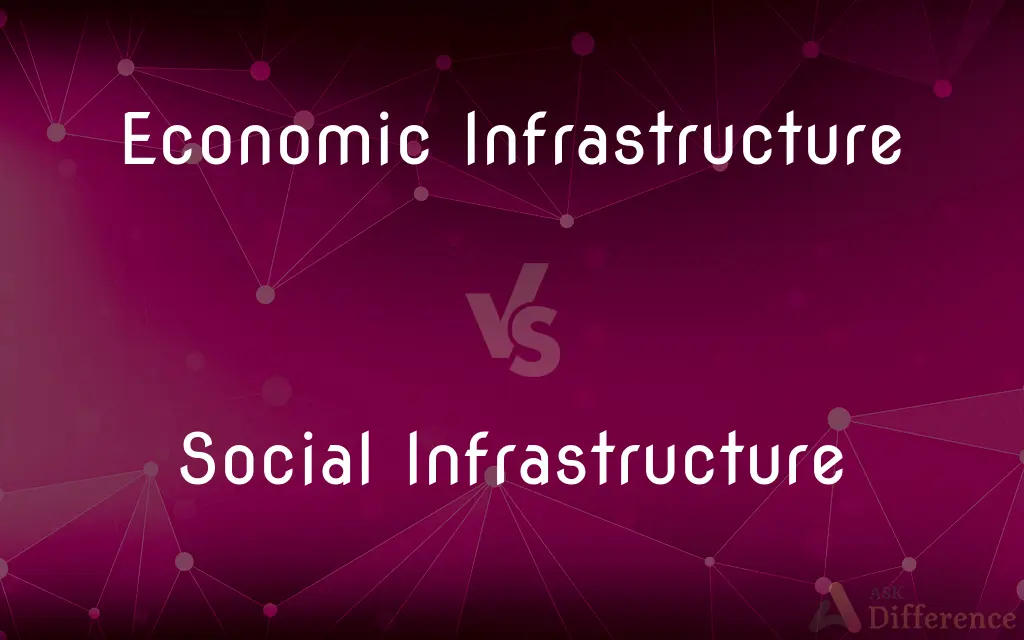Economic Infrastructure vs. Social Infrastructure — What's the Difference?
Edited by Tayyaba Rehman — By Maham Liaqat — Published on July 21, 2024
Economic infrastructure supports economic activities directly, while social infrastructure enhances the quality of life and societal well-being.

Difference Between Economic Infrastructure and Social Infrastructure
Table of Contents
ADVERTISEMENT
Key Differences
Economic infrastructure refers to the physical and organizational structures necessary for the operation of an economy, including transportation systems, energy supply networks, and telecommunications. On the other hand, social infrastructure encompasses the facilities and institutions that contribute to the social well-being and quality of life of a population, such as schools, hospitals, and public housing.
Investments in economic infrastructure are typically geared towards enhancing productivity, generating income, and promoting economic development. This can include the expansion of roads, bridges, ports, and utilities. Whereas, investments in social infrastructure are primarily concerned with improving living standards and providing access to essential services like healthcare and education, which indirectly support economic growth by developing human capital.
The development and maintenance of economic infrastructure are often seen as a prerequisite for attracting investment and stimulating economic activities. Efficient transportation and reliable energy sources reduce operational costs and increase competitiveness. In contrast, social infrastructure, while not directly linked to economic productivity, plays a critical role in societal development and stability by ensuring access to basic services and fostering a skilled workforce.
Public-private partnerships (PPPs) are commonly used to finance and manage projects in both types of infrastructure, but the investment rationale differs. Economic infrastructure projects often generate direct revenue streams, such as tolls or user fees, making them more attractive to private investors. Social infrastructure projects, however, may rely more on government funding or subsidies due to their non-revenue generating nature and the emphasis on public service and equity.
Despite their differences, economic and social infrastructure are interdependent. Efficient economic infrastructure enhances the delivery of social services by improving accessibility and reducing costs. Conversely, high-quality social infrastructure can enhance economic productivity by improving health outcomes and education levels, thus contributing to a more robust and capable workforce.
ADVERTISEMENT
Comparison Chart
Primary Focus
Support economic activities and growth
Enhance quality of life and social well-being
Examples
Transportation, energy, telecommunications
Schools, hospitals, public housing
Investment Rationale
Enhance productivity, generate income
Improve living standards, access to services
Revenue Generation
Direct through user fees, tolls
Indirect, often government-funded
Interdependence
Facilitates trade and business operations
Builds human capital, supports societal stability
Compare with Definitions
Economic Infrastructure
Infrastructure projects that can directly produce revenue.
Toll roads are a classic example of income-generating economic infrastructure.
Social Infrastructure
Systems and facilities that contribute to the stability and cohesion of society.
Affordable housing projects support societal stability by ensuring that all community members have a place to live.
Economic Infrastructure
Essential structures and systems that enable and enhance economic activities.
The new port serves as a pivotal economic infrastructure, boosting regional trade.
Social Infrastructure
Infrastructure that provides the population with health, education, and housing.
Public schools play a crucial role in providing access to essential educational services.
Economic Infrastructure
Infrastructure that supports economic expansion and competitiveness.
Investment in renewable energy infrastructure drives sustainable economic growth.
Social Infrastructure
Infrastructure focused on delivering services to meet public needs.
Community centers are key social infrastructures serving public social needs.
Economic Infrastructure
Assets that increase efficiency in production and services.
Modern telecommunications infrastructure is a key productivity booster for businesses.
Social Infrastructure
Facilities and institutions aimed at improving societal well-being.
The new hospital significantly enhances the region's social infrastructure and quality of life.
Economic Infrastructure
Structures that enhance the functioning of markets through better connectivity and reliability.
Efficient logistics infrastructure improves market efficiency by reducing delivery times.
Social Infrastructure
Investments that contribute to the development of a skilled and healthy workforce.
Investments in educational facilities are vital for human capital development.
Common Curiosities
What is the main difference between economic and social infrastructure?
Economic infrastructure directly supports economic activities and growth, whereas social infrastructure focuses on enhancing the quality of life and societal well-being.
What role does economic infrastructure play in a country's competitiveness?
It reduces operational costs, improves market access, and enhances overall efficiency, making the country more attractive for investment and business operations.
Can infrastructure be both economic and social?
Some infrastructure elements might overlap in functions, serving both economic and social purposes, but they are generally categorized based on their primary focus.
Is it more beneficial to invest in economic or social infrastructure?
Both are crucial; economic infrastructure boosts immediate economic productivity and growth, while social infrastructure lays the foundation for long-term societal health and development.
How do technological advancements impact infrastructure development?
Technological advancements can lead to more efficient, sustainable infrastructure solutions, impacting both economic and social infrastructure development.
How can infrastructure development be made sustainable?
By incorporating green technologies, sustainable materials, and considering long-term environmental impacts in the planning and construction phases.
What is the future of infrastructure development?
The future of infrastructure development likely includes increased emphasis on sustainability, resilience to climate change, and integration of technology to improve efficiency and services.
Why is investment in social infrastructure important for economic growth?
Investing in social infrastructure like education and healthcare indirectly supports economic growth by developing a healthier, more educated workforce.
How do public-private partnerships work in infrastructure development?
PPPs involve collaboration between government entities and private companies to finance, build, and operate infrastructure projects, often combining public interest goals with private sector efficiency.
How does social infrastructure impact societal development?
By providing essential services like education and healthcare, it improves living standards, supports human capital development, and ensures societal stability.
Can lack of social infrastructure affect economic development?
Yes, a deficiency in social infrastructure can lead to a less educated and less healthy workforce, indirectly hindering economic growth.
How do governments prioritize infrastructure projects?
Governments prioritize projects based on factors like economic impact, public need, available funding, and strategic importance for long-term development.
What challenges do developing countries face in infrastructure development?
Limited financial resources, lack of expertise, and governance issues are common challenges that hinder effective infrastructure development in developing countries.
How does infrastructure affect urban versus rural areas differently?
Urban areas may have better access to both economic and social infrastructure, while rural areas often face challenges in accessing these essential services, impacting economic and social development.
What is the environmental impact of infrastructure development?
Infrastructure development can have significant environmental impacts, including habitat destruction and pollution, requiring careful planning and sustainable practices.
Share Your Discovery

Previous Comparison
RMP vs. SMP
Next Comparison
Acquire vs. ProcureAuthor Spotlight
Written by
Maham LiaqatEdited by
Tayyaba RehmanTayyaba Rehman is a distinguished writer, currently serving as a primary contributor to askdifference.com. As a researcher in semantics and etymology, Tayyaba's passion for the complexity of languages and their distinctions has found a perfect home on the platform. Tayyaba delves into the intricacies of language, distinguishing between commonly confused words and phrases, thereby providing clarity for readers worldwide.










































